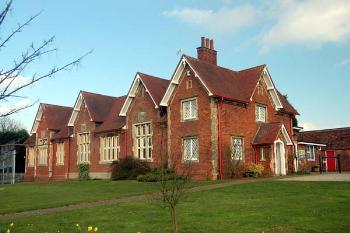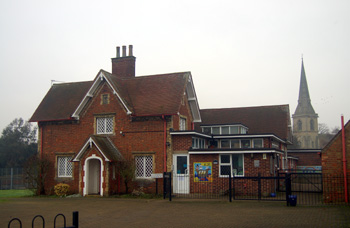Ridgmont School

Ridgmont Lower School March 2007
A rural deanery proforma parish survey of 1848 [AB/RD/A0] states: "Day School of about 30 children taught in a miserable low room". It also noted: "There area great many Baptists & Wesleyans, who have good Schools". The Baptists ran a large Sunday school but the Wesleyans ran a daily school.
The first mention of this Anglican daily school otherwise is in The Post Office Directory of 1854 where it is called a National School but there is no evidence it was ever in union with the National Society. The master was George Stanton. A directory of 1864 lists Charles Thomas Humphreys as the master and The Post Office Directory of 1869 lists Miss Hadwin as the mistress.
The first Education Act was passed in 1870 (more correctly it was known as the Elementary Education Act). It was a milestone in the provision of education in Britain demonstrating central government's unequivocal support for education of all classes across the country. It also sought to secularise education by allowing the creation of School Boards. These were groups of representatives, elected by the local ratepayers and the Board had the powers to raise funds to form a local rate to support local education, build and run schools, pay the fees of the poorest children, make local school attendance compulsory between the ages of 5 and 13 and could even support local church schools, though in practice they replaced them, turning them into Board run schools (known as Board Schools). A questionnaire was sent to every parish in the county in connection with the act and the Ridgmont return stated that the Church of England School could accommodate 121 children. It stated that a school for seventy infants near the Church School was required.
In 1871 an entry in the Baptist Church book in 1871 [X347/3] notes: "the church agreed to the Duke of Bedford's request that the room adjoining the chapel be used as an infant school during the erection of another building". This was an extension to the main school which is still in use today [2012]. It took some time to build this extension because the Baptist Church book later noted: "Between 1876 and 1878 the infant day school removed to the new premises erected by the Duke of Bedford adjoining the other schools". The new infants' school opened at Christmas 1878
In 1878 the Ridgmont School Board was formed. Among other things they decided that religious instruction should take the form of a short Collect and the Lord's Prayer, and Bible instruction. Clearly it was felt that the inhabitants did not value the new school as a letter of 1884 in the Duke's correspondence, just six years after the infant school opened, states R4/938] that it had "the dirtiest…and most uncared for appearance of any school…"
A land mark Education Act was passed in 1902, coming into effect in 1903. It disbanded the School Boards and gave day to day running of education to newly formed Local Education Authorities, usually the county council, as in Bedfordshire. The old Board Schools thus became Council Schools whilst the old National, British and other non-Board schools became known as Public Elementary Schools. The new Local Education Authority, the Education Committee of Bedfordshire County Council, consisted of fifteen one of whom, Rev. W. Baker had been the chairman of Ridgmont School Board. The school was henceforth known as Ridgmont Council School.
Bedfordshire & Luton Archives & Records Service has a scrapbook of reports on most of the county's schools made by the School Inspector for a period from just before the First World War through the inter-war years [E/IN1/1].In 1911 the Inspector noted: "Order and tone are very praiseworthy and a very creditable standard of efficiency is reached both in the Infants' Class and in the School for the older scholars. The work of the older children is characterised by painstaking care and they make good progress. The Infants are brightly and well taught and their attainments do credit to the Teacher".
Two years later he reported that: "This is a thoroughly good village School. In all sections comprising both Infants and older Scholars very creditable work is done. Order and tone and excellent, and Singing and the written exercises are very praiseworthy. A pleasing feature of the School is the successful attempt made to teach the children to speak distinctly and accurately. The Infants' Class is brightly and intelligently taught and the little ones make good progress. The condition of the School as a whole reflects much credit upon the Head Mistress and her Assistants".
Inspections did not occur during the First World War but the logbook shows how pupils did their bit for the war effort. On 18th October 1918 " a small jumble sale was held immediately after school by the scholars & teachers; the parents & people of the village came and bought the things & the little bazaar was well attended; the proceeds will be expended on wool etc for the children's war knitting and soldier's comforts". [SDRidgmont1].
In 1921 and 1922, average attendance 72, the Inspector found: "This School is, as it was when the last report was submitted, a very good villageSchool. There is, in all work in books, abundant evidence of careful teaching and correction; the Infants' class is well managed; speech training is not overlooked and enunciation in song is very good, the School having won a challenge shield and a third prize at the Eisteddfod against strong opposition" [the Eisteddfod was an arts competition for school introduced by Bedfordshire County Council between the wars, borrowing a Welsh idea]. "The desirability of a greater variety in the exercises in Composition, of a more definite aim in Needlework, and of obtaining correct sounds (both of vowels and consonants) early was mentioned at the second visit. The Infants read very well. There are only 5 in the first class; a variety of suitable stories should be supplied for them to read".
In 1925 the report was even more glowing: "The new Head Teacher is doing thoroughly good work. The appeal to the individual child is much stronger than formerly, and exceptional attention is given to expression, both oral and written. There is every prospect of sound progress. The order and tone leave nothing to be desired". In 1929 "The Head Mistress was absent, ill, at this visit, but the work seen and heard shows clearly that she is obtaining a very good standard of work. The children are unusually responsive, and the Teachers are anxious that their work should be seen".
By the next report in 1931 things had changed: "Since the last report was written, this has become a Junior School under a Certificated Head Teacher and a Supplementary Assistant. The choice of the Head Teacher was very happy; she has made out good schemes of work, and obtained very satisfactory results from a class of children who have always proved responsive at visits of inspection. There seems to be little to criticize in the work done by the older children – in fact the print script and the change to cursive are both praiseworthy in their neatness; the reading is good as "reading" and the children can follow the content well; Arithmetic, neat and accurate in books, stood the test of mental questions, some of them often addressed to far older children, well. Spelling is continually kept in mind, taught, and tested. Geography, Drawing, Singing, Physical Training, and History, were all subjected to tests of varying thoroughness: the children came out well; but in History certain suggestions as to chronology were made, and in Singing reference was made to the claims of the Old Notation".
"The Infants, too, are doing very well. Here, the Handwork is rather too imitative. Beyond this, there is not, at present, much to criticize, whereas the general progress has much that is commendable".
"The behaviour and manners of the children in School are good".
The 1934 report continues the upbeat theme present ever since 1911: "This is a very good Junior School. The written work and the setting out of Arithmetic is up to the best level of such work, and the power of reading and willingness to recite is also praiseworthy. The children speak out well and are word perfect; some of their vowel sounds however might be more correctly rendered".
"Needlework is also a good feature. In this connection the visiting Inspectors were much impressed by the [needle]work done by a child who is practically blind; and in the books the progress made by this girl and her brother, who is equally afflicted, reflects the greatest credit on the patient kindness and skill of the Head Mistress".
The final report, for May 1938, noted: "Since January 1938 45 children have been admitted, and the number on books is now 82, though 6 have left in the same period. The growth is due to a development of Housing at Brogborough, largely no doubt because of the new brickworks: the children come mainly from Peterborough; Newcastle; South Wales; and other Bedfordshire villages".
"The staff, formerly Head Teacher plus Supply Teacher, both of whom are good Teachers whose work has always been very praiseworthy, has been increased by a second Supply Teacher, who has come back to Teaching after a lapse of some years. There is some evidence that she may not be well equipped enough to cater for all the needs of the 27 5 and 6 [year old] children in her Infants class, especially as regards Reading and Speech".
"The top class contains children behind standard in attainment but for the most part mentally alert: the Teaching is careful and skilful and they are responding well – progress is evident".
"The Teacher of the second class was absent but is, also, doing sound work in rather difficult circumstances".
The third of the great Education Acts was that of 1944 which established the principle of County Primary Schools for children up to the age of 11, at which time they took an examination to determine the nature of the secondary school they would attend until they were 15, the most academically able going to grammar schools, the rest to secondary or secondary modern schools. Following the act, in 1946, Ridgmont School duly became a County Primary School. Meanwhile, pupils must have enjoyed celebrating Victory Europe Day at the end of World War Two as the logbook entry for 11th May 1945 reads: '"school reopened this morning with a very poor attendance, after the National Holiday and Peace Celebrations" [SDRidgmont 1].
In the 1970s Bedfordshire County Council introduced comprehensive education, doing away with the 11+ examination and grammar schools and introducing a tier of school between the old County Primary and County Secondary Schools. Thus Lower Schools now taught children aged 4 to 9, Middle Schools from 9 to 13 and Upper Schools from 13 onwards. Ridgmont duly became a Lower School which it remains to this day, still in the 19th century school building near the church and set back from the High Street.
 Ridgmont Lower School December 2010
Ridgmont Lower School December 2010